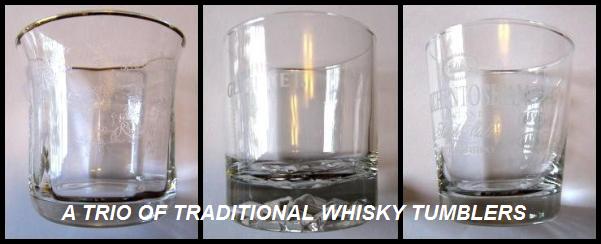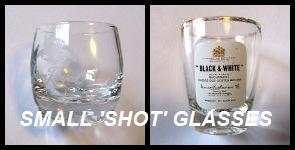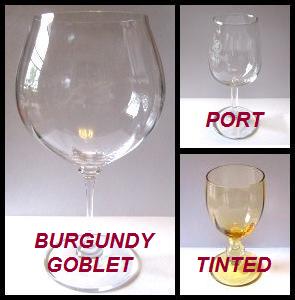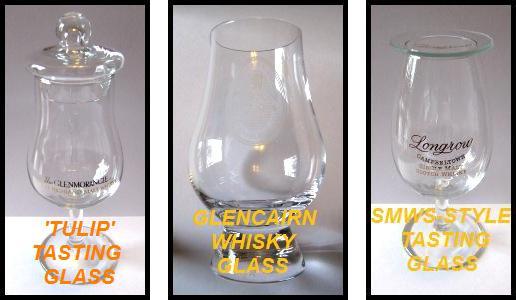A Rich Pour 25: Tumblers & Tasting Glasses
So many whiskies… So many types of glasses… Is there a secret to matching one with the other to best effect? Join Cigar Weekly Managing Editor Doug Kuebler (jazznut) as he investigates how a glass can influence appreciation of the whisky poured into it.
Monday September 29, 2014
When I was a youngster, many of the adults I knew drank hard liquor simply because that was the sociable thing to do. Those who were into whisky (or whiskey – I’ll stick to the term ‘whisky’ for the sake of simplicity) tended to pour generously, adding ice, soda water or whatever else struck their fancy – probably to mellow out that ‘hard’ aspect. ‘Neat’ was a concept still in its infancy, and cut-crystal highball and rocks glasses were de rigueur.

How times have changed. Not that social drinking has gone the way of the dinosaurs. Meeting with friends and acquaintances over a whisky or two remains a relaxing and rewarding blog, after all. What is different is how important the matter of taste has become, and how a more eclectic approach to spirits has eroded ‘blind’ brand loyalty. Publications and internet exchanges discussing the merits of various whiskies have brought aroma and flavour into the limelight. Many of us are actually taking a moment here and there to get to the bottom of the whiskies we’re drinking, and to share our impressions with those around us. In an analytic sense, we’ve ‘grown up’.
No wonder. With single malt this and small batch that flowing into the marketplace at lightning pace, whisky consumers are faced with the increasingly complex challenge of deciding how much to spend, what to buy, and why.
Enter the ‘lowly’ glass, the ‘delivery service’ of aroma and flavour. Is it any wonder that the variety of glassware specifically targeted toward whisky drinkers has expanded over the last while? Whisky, meet the whisky tasting glass.
When we think of flavour, we tend to focus on the role of the tongue and palate, where our taste buds are busy deciphering sweetness, sourness, saltiness, various kinds of bitterness, and umami. Yet our sense of taste actually relies far more on volatile, aromatic molecules that find their way from the palate to the olfactory mucous membrane. Add to this the multitude of fragrances we sense directly through our nasal passages, and it’s fair to say, “The nose knows.”
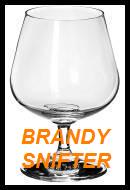
The shape of a glass can therefore make a tremendous difference in how we perceive a whisky. Tumblers suffice if we’re going the ‘on the rocks’ or ‘mixed’ route, and if we aren’t too concerned about the total taste experience. (Tumblers often display what’s known as a divergent rim design, with sides that slant outward from the base of the bowl to the rim.) Miniature shot glasses are self-explanatory. Forget about them. Wine goblets (no tinted ones – we’re eyeballing whisky, not staring into bright sunlight) represent a step in the right direction, but may be oversized. Brandy snifters make for a reasonable, if not always ideal, alternative. And Port glasses, though nicely proportioned for the task at hand, come up a little short – literally. What we really need is a glass that allows us to experience everything a whisky has to offer. Our search for the ‘perfect’ shape of whisky glass has begun.
I’ve assembled eight different glasses – four ‘outside contenders’ and four marketed as whisky glasses – to compare. The first group includes cognac, grappa and ISO (International Organization for Standardization) wine tasting glasses as well as a sherry copita. The second group comprises the standard Glencairn whisky and Glencairn Canadian whisky glasses as well as classic tulip-shaped (with lid and Glenmorangie logo) and Scotch Malt Whisky Society-style (or SMWS-style, with lid and Longrow logo) glasses. The Riedel Vinum single malt whisky glass (a parfait glass-like and not very successful design) and controversial NEAT glass (a more radical design that has garnered some praise and much criticism) are notably absent. I haven’t purchased either of these, and won’t. Now, let’s carry on to specifics.
A larger rim diameter increases the area from which the vapours of an alcoholic beverage can escape the glass and pass into the air above. It may broaden the range of fragrances emanating from the spirit in the glass at any given moment. However, a larger rim diameter can also increase the rate of evaporation, thereby decreasing the volatility and overall aromatic integrity of the spirit more rapidly. Glasses with wider mouths usually perform better with more intense or higher proof whiskies. They also permit the taster to position his or her nose further down into the glass (and thus closer to the surface level of the spirit).
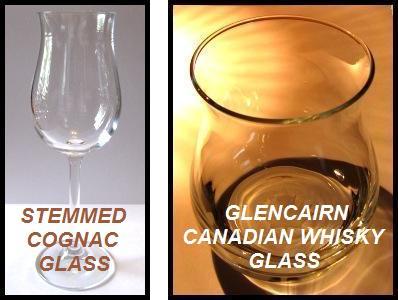
The Glencairn Canadian whisky glass is clearly in a league of its own here, making it a prime candidate for barrel strength or high proof Bourbons, cask strength spirits, and perhaps even heavily peat-reeked whiskies. It’s also the only ‘rocks ready’ glass in the running. I’m not so sure about the national nomenclature, however, given the understated style of many a Canadian whisky. The cognac, standard Glencairn whisky and ISO wine glasses exhibit moderately wide mouths. The cognac glass, for me, strikes a nice balance between exposing fragrances and maintaining volatility.
A glass with a convergent rim design has sides that slant inward from the widest portion of the bowl to the region of the rim. This style includes most tasting glasses as well as the archetypal brandy snifter. Grappa glasses, with their round bowls and straight sides, are merely a variation on this theme. Such narrowing focuses any aromas evaporating off the surface of the spirit. And although this focusing effect may decrease the range of fragrances emanating from the spirit in the glass at any given moment, it can also allow the spirit to ‘breathe’ for a longer period without the alcohol dissipating (or the aromatic integrity of the spirit being compromised) too rapidly. Glasses with very convergent rim design and narrow mouths often seem to work best with lighter-styled, more delicately flavoured whiskies.
The grappa and SMWS-style glasses focus aromas to the extreme. Both highlight the drier, crisper, harsher characteristics of a spirit, and seem better suited for lighter, sweeter, fruitier whiskies. The standard Glencairn, ISO, tulip and sherry glasses aren’t as intrusive in terms of limiting aromatic complexity, though all four tend to marginally accentuate the intensity and oak-derived traits of whiskies at the expense of more delicate floral and fruity notes – a subtle yet noticeable effect. The cognac glass brings a tad greater sweetness to the fore, and moderates the intensity of a whisky without killing it.
The initial surface level of spirit in a glass of convergent rim design should ideally lie at or near a point corresponding to the widest bowl diameter, thereby providing the greatest surface area for aromas to evaporate upward in the glass. Lowering this level lessens the surface area of the spirit, but at least allows gentle rotating or swirling of the liquor to encourage additional aeration. Raising this level, however, places the surface area higher up into the glass beyond the ‘sweet spot’ of the bowl. Some glasses are better suited to a ‘standard’ 30 millilitre dram, while others may benefit from larger or smaller pours. This factor could be of concern in the case of a comparative tasting of many whiskies, where pours would be strictly measured.
Seven of the eight glasses provide an acceptable fill level with a 30 millilitre pour of whisky. The tulip-shaped tasting glass and sherry copita are best in this regard, and the grappa glass worst (too high a fill level). All of the others need a slightly larger quantity of whisky to bring the fill level up to the ‘sweet spot’ of the bowl. “No problem,” I say.
An outward flare at the rim of a glass facilitates delivery of spirit to the lips, tongue and palate. Such a feature may also help to accentuate the appreciation of certain flavours. In contrast, a glass with highly convergent sides at its rim can make sipping awkward, especially if it is very small in circumference at the top.
The cognac and Glencairn Canadian whisky glasses, both of which have outward rim flares, stand apart from the others. I’m partial to this design feature, as it helps to spread spirit across a wider section of the tongue. The grappa, SMWS-style, tulip-shaped and sherry glasses deliver whisky to a significantly smaller area of the tongue. I also find the SMWS-style glass, with its sides severely angled inward near the rim, slightly difficult to sip from.
Glass thickness is an issue in terms of fragility versus durability. While a thinner gauged tasting glass may feel lighter and better balanced in the hand, it can also be far more susceptible to breakage. Goodness knows, I’ve ‘toasted’ more than my fair share of glassware down through the years. Glass thicknesses vary from 1 millimetre or less (delicate, high quality tasting glasses) to 2.5 millimetres or more (heavy tumbler-style glasses). Most worthwhile whisky tasting glasses (including all of the ‘true’ whisky glasses profiled here) fall in the 1.25 to 1.5 millimetre thickness range.
Should a whisky glass have a stem, or shouldn’t it? Both of the Glencairns, with their stem-less designs, will obviously stand up to a fair amount of abuse. Little wonder that the standard Glencairn whisky glass has become a fixture at many a spirits tasting session. Besides, long, thin stems seem custom-made for snapping. That said, I actually prefer a stemmed glass, which allows me to hold it away from the bowl area. (I’m not in the ‘warm a whisky in your cupped hand’ camp.)
And so, we have the finalists. These are my picks. Your choices may well differ.
Best for ‘big’ (high proof or cask strength) whiskies:
Glencairn Canadian whisky glass
- Cognac glass
Best for standard strength (40% to 50%ABV) whiskies:
- Cognac glass
- Standard Glencairn whisky glass
Most versatile:
- Cognac glass
- Standard Glencairn whisky glass
Most durable:
- Glencairn Canadian whisky glass
- Standard Glencairn whisky glass
It’s worth noting that my overall favourite whisky tasting glass, the cognac glass, has a design rather similar (apart from displaying slightly more rounded contours as well as being less rim convergent and a bit larger) to that of the Eisch malt whisky glass, which was judged best for nosing in multiple categories (blended whiskies, single malts and cask strength malts) by a Whisky Magazine panel. My runner-up choice, the standard Glencairn whisky glass, does a more than fair job of displaying the positives and negatives of a spirit, and remains a solid option for large scale comparative tastings or regular at home usage.
Conclusion: There is no single best tasting glass for every whisky out there. So be a little adventurous. Try different combinations, and see what works for you.
Slàinte!
Referenced articles and books
Chartier, François, Taste Buds and Molecules: The Art and Science of Food with Wine, translated by Levi Reiss, McClelland & Stewart, Toronto, Canada, 2010, pp. 35-37, 79, 81, 111





